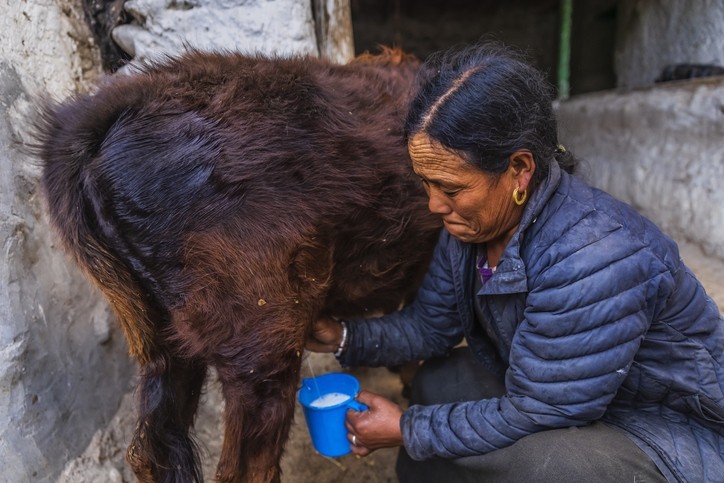The Milky Way: Transformation of Nepal’s dairy sector 'an example' for Asian countries seeking modernisation

This 10-year Program is a joint initiative by Heifer International and the governments of Nepal and South Korea.
Heifer International is a global nonprofit organisation that works with smallholder farming households in low- and middle-income countries, sustainably addressing poverty.
The objective is to help 500,000 smallholder farming families significantly increase their incomes while reducing Nepal’s heavy dependence on imported dairy products.
Approximately 65% of Nepali households depend on agriculture for their livelihoods and food security, and half of them keep at least one dairy animal. However, most cows are not raised for commercial purposes, providing meagre quantities of milk — less than a tenth of yields in countries like the U.S. or South Korea.
Only about 14% of milk-producing households are both producers and sellers, with the remainder producing milk solely for personal consumption, indicating untapped income potential.
“Confronted by low productivity, underdeveloped dairy markets and weak agricultural support services, most smallholder farmers are unable or unwilling to invest in improving their milk productivity and quality. The Milky Way Program addresses these challenges through a systems-level, holistic approach in partnership with public and private stakeholders at the global, national, regional and local levels,” said Milky Way program director Keshav Sah.
The three pathways
The Milky Way Program consists of three complementary pathways.
The first is to develop a smallholder-led dairy production model, piloted in the Model Dairy Village in Sindhuli District. It will have a uniform system in all 500 households.
The second pathway focuses on scaling up the practices and market systems developed in Sindhuli across Nepal – this includes technical assistance to dairy producers, service providers, and breeding agency staff.
This will improve market incentives for the dairy industry, improve access to financial aid for farmers and other stakeholders, and forge partnerships between public and private sectors.
The third pathway addresses challenges in Nepal’s dairy ecosystem. It aims to create a business and regulatory environment that allows Pathway 2 to achieve maximum and sustained impact. The National Dairy Development Board and provincial dairy development boards will take the lead here.
Challenges in Nepal’s dairy industry
Nepal has to provide for a population that has grown from 14 million in 1975 to more than 31 million in 2024.
Around 14% of the population are currently working abroad. They are driven by poverty or unable to make a decent living at home, especially in rural areas.
The key assumption is, increasing income potential in rural areas could encourage more people to stay, boosting local dairy production.
Heifer staff and farmers said local crossbred cows are currently earning their owners 8,000–10,000 NPR a month while a purebred Holstein or two crossbred cows with Holstein genetic material can bring in 40,000–50,000 NPR a month.
Nepal also suffers from a basic milk supply deficit. Additionally, the poor quality of many domestically manufactured dairy products such as ice cream and yoghurt led to consumers seeking imported products.
According to a 2020 study, the average nutritional consumption requirement for milk was 91L per person per year while the country was producing just 79L per person per year.
Also, the estimated daily shortfall between supply and demand was 550,000L between 2021 and 2022. This gap is forecast to widen in future, threatening food security.
To increase dairy productivity, it will require tackling two primary issues: poor animal nutrition and poor animal genetics.
Most smallholder farmers are reluctant to invest in productivity improvements due to high costs, low market confidence, and inadequate breeding support.
Another key concern is the questionable quality of raw milk supplied by farmers to milk processors, who often complain about rapid spoilage due to bacterial contamination.
Heifer therefore proposed that farmers be paid not only for the fat content of their milk but also for its hygienic quality – the lower the bacterial count, the more farmers will be paid. To support this, authorities plan to establish a dairy processing centre in the Model Dairy Village, where one of the objectives is to demonstrate how good, clean milk can be produced in large quantities.
To improve animal genetics, artificial insemination will be used – a solution that arose from the government's collaboration with Heifer that started in 2019 due to a shortage of high-quality semen.
Financing the Program
The Milky Way Program was launched in December 2022. Heifer facilitated shipments of more than 100 high-genetic-value heifers, bull calves and bulls, all of which came from South Korea.
Since then, the Model Dairy Village has had a nucleus herd of pedigreed Holstein cows, managed and owned by smallholder farming families.
South Korean bulls managed at Nepal’s National Livestock Breeding Offices are also beginning to supply high-quality semen for use of artificial insemination across the country.
Costs are currently borne by Heifer entities and the municipality, along with donor funds and pro-bono assistance from South Korean experts. The objective is to make Nepal’s dairy production self-sustaining, with support from both the government and the private sectors.
For example, the costs of shed construction, chaff cutters, water tanks and stands — which represent some of the more significant capital expenses of the Model Village approach — are divided between Heifer, donor organisations like the Korea International Cooperation Agency, Kamalamai Municipality and the farmers.
Heifer will eventually phase out its financing of the Program. But it will first ensure that farmers are able to cover their costs, which can take a year or longer.
So far, the results have been encouraging.
In May 2024, several farmers were in the process of applying for loans and drawing up business plans with the help of community-level bank facilitators.
“The stakeholders’ common goal is that the Milky Way Program will help catalyse a stronger, more profitable and more self-sustaining dairy sector that benefits not only smallholder farmers but also multiple actors along the dairy value chain, as well as Nepali consumers in the form of higher-quality and readily available domestically produced dairy products.
“The Nepal Government also aspires to set an example for other low- and middle-income countries facing similar challenges in dairy development,” said Charlie Pye-Smith, agriculture expert and author of The Milky Way Program report.

















